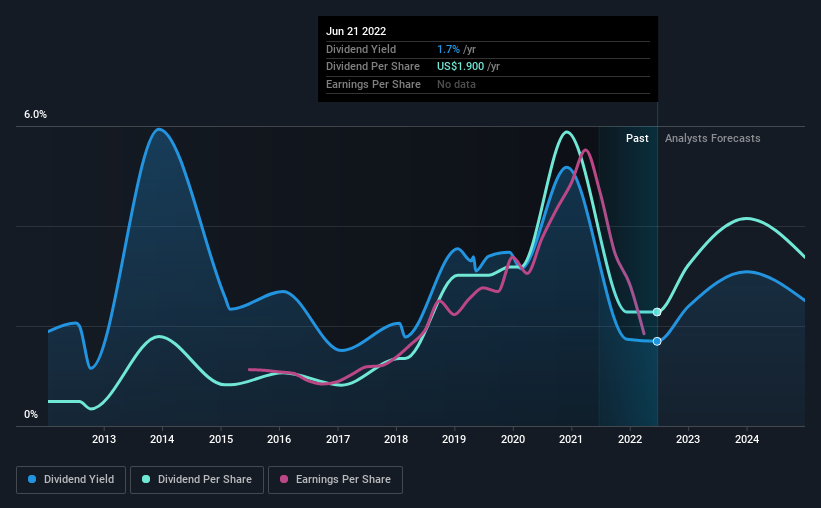Progressive (NYSE:PGR) Has Re-Affirmed Its Dividend Of US$0.10
The board of The Progressive Corporation (NYSE:PGR) has announced that it will pay a dividend of US$0.10 per share on the 15th of July. The dividend yield is 1.7% based on this payment, which is a little bit low compared to the other companies in the industry.
View our latest analysis for Progressive
Progressive's Payment Has Solid Earnings Coverage
Even a low dividend yield can be attractive if it is sustained for years on end. Based on the last payment, Progressive was quite comfortably earning enough to cover the dividend. This indicates that a lot of the earnings are being reinvested into the business, with the aim of fueling growth.
Over the next year, EPS is forecast to expand by 14.4%. If the dividend continues along recent trends, we estimate the payout ratio will be 57%, which is in the range that makes us comfortable with the sustainability of the dividend.
Dividend Volatility
Although the company has a long dividend history, it has been cut at least once in the last 10 years. The first annual payment during the last 10 years was US$0.41 in 2012, and the most recent fiscal year payment was US$1.90. This means that it has been growing its distributions at 17% per annum over that time. Dividends have grown rapidly over this time, but with cuts in the past we are not certain that this stock will be a reliable source of income in the future.
The Dividend Looks Likely To Grow
Growing earnings per share could be a mitigating factor when considering the past fluctuations in the dividend. It's encouraging to see Progressive has been growing its earnings per share at 12% a year over the past five years. Shareholders are getting plenty of the earnings returned to them, which combined with strong growth makes this quite appealing.
We Really Like Progressive's Dividend
Overall, we like to see the dividend staying consistent, and we think Progressive might even raise payments in the future. Distributions are quite easily covered by earnings, which are also being converted to cash flows. Taking this all into consideration, this looks like it could be a good dividend opportunity.
It's important to note that companies having a consistent dividend policy will generate greater investor confidence than those having an erratic one. Meanwhile, despite the importance of dividend payments, they are not the only factors our readers should know when assessing a company. Taking the debate a bit further, we've identified 2 warning signs for Progressive that investors need to be conscious of moving forward. If you are a dividend investor, you might also want to look at our curated list of high yield dividend stocks.
Have feedback on this article? Concerned about the content? Get in touch with us directly. Alternatively, email editorial-team (at) simplywallst.com.
This article by Simply Wall St is general in nature. We provide commentary based on historical data and analyst forecasts only using an unbiased methodology and our articles are not intended to be financial advice. It does not constitute a recommendation to buy or sell any stock, and does not take account of your objectives, or your financial situation. We aim to bring you long-term focused analysis driven by fundamental data. Note that our analysis may not factor in the latest price-sensitive company announcements or qualitative material. Simply Wall St has no position in any stocks mentioned.

 Yahoo Finance
Yahoo Finance 
